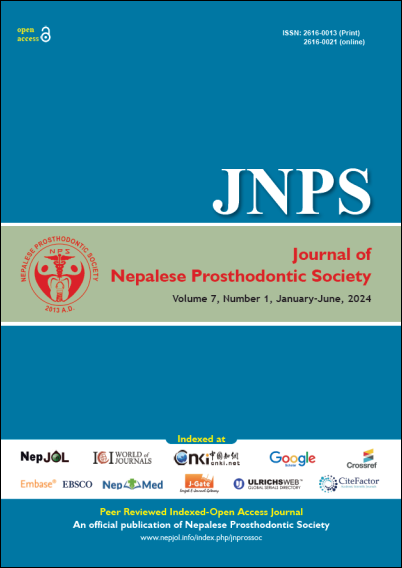Evaluation of marginal fit of conventional, milled, and direct metal laser sintered cobalt chromium crowns: A comparative study
DOI:
https://doi.org/10.3126/jnprossoc.v7i1.70455Keywords:
Buccal fit, Cobalt-chromium crown, Computer-aided design and manufacturing, Direct metal laser sintering, Marginal fit, Occlusal fitAbstract
Introduction: A close marginal adaptation of a fixed partial denture is crucial for its long-term functionality without any adversity. Human errors and casting defects are common with conventional techniques. The latest techniques, direct metal laser sintering (DMLS), and computer-aided design and manufacturing (CAD/CAM) tend to overcome these errors.
Methods: 33 dies were fabricated from similar number of impressions of a tooth based on standardized measurement and were equally distributed in 3 groups (11 each). Crowns were fabricated using conventional, DMLS, and CAD/CAM methods using chrome-cobalt. All the fabricated crowns were cemented onto the die using resin cement and 50 N force, followed by leaving them for 12 hours at room temperature. Then, each crown was sectioned into two halves, and a stereomicroscope was used to evaluate the cement thickness at three different reference points.
Results: The marginal fit of conventionally fabricated crowns, DMLS, and CAD/CAM crowns were in the clinically acceptable range. Marginal discrepancy remained more in conventionally fabricated crowns than in CAD/CAM and DMLS crowns. However, the axial discrepancy in crowns fabricated by the conventional method was lesser than in CAD/CAM and DMLS fabricated crowns. The occlusal discrepancy in DMLS-fabricated crowns was more than that of the other two methods.
Conclusion: The DMLS group displayed better marginal accuracy with respect to the marginal reference point. On the other hand, the convention group exhibited superior adaptability when the buccal and occlusal reference points were considered. Similarly, statistically significant results were observed when the conventional group's 'margin reference point' was compared with the CAD/CAM or DMLS group. The margin reference point of the CAD/CAM group was comparable with DMLS cobalt-chromium crowns.
Downloads
Downloads
Published
How to Cite
Issue
Section
License
Copyright (c) 2024 The Author(s)

This work is licensed under a Creative Commons Attribution-NonCommercial-NoDerivatives 4.0 International License.
This license enables reusers to distribute, remix, adapt, and build upon the material in any medium or format, so long as attribution is given to the creator. The license allows for commercial use. © The authors




